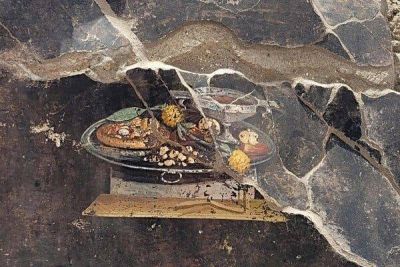A still life fresco resembling a pizza was found among the ruins of ancient Pompeii. The fresco, which dates back 2,000 years, emerged during excavations in the Regio IX area of Pompeii’s archaeological park, which is close to Naples, the birthplace of pizza. The painting was on a wall in what is believed to have been the hallway of a home that had a bakery in its annex. The fresco appears to depict a round focaccia bread on a silver tray serving as a support for various fruits, including a pomegranate and possibly a date. Experts say the bread is seasoned with spices or moretum, a herb cheese spread eaten by the ancient Romans. Next to the bread is a goblet of wine, along with dried fruit, dates, pomegranate, and a garland of yellow arbutus. The still life is thought to have been inspired by the Greek hospitality ritual of xenia, and so the tray represented gifts that were offered to guests as part of a tradition dating back to the Hellenistic period. Such images were widespread in the homes of ancient Pompeii and nearby Herculaneum, which were both wiped out when Mount Vesuvius erupted in 79 AD. The Italian culture minister, Gennaro Sangiuliano, said Pompeii “never ceases to amaze”. “It is a treasure chest that always reveals new treasures,” he added.
Tra le rovine di Pompei è stato ritrovato un affresco che assomiglia una pizza. L'affresco, che ha più di 2.000 anni, è stato scavato nell'area Regio IX del parco archeologico di Pompei. L'affresco si trova su un muro che fece parte di una casa che ebbe un panetteria in dietro. L'affresco ha un'immagine che sembra una focaccia su un vassoio d'argento con diversi frutti, come una melagrana e un dattero. Gli esperti dicono che la focaccia è condita con spezie o mortem, un tipo di formaggio mangiato dagli antichi romani. C'è anche un bicchiere di vino, frutta secca, datteri, melograni e una ghirlanda di foglie verdi. Si pensa che l'affresco si ispiri a un rito degli antichi greci chiamato "Xenia". Questo rituale fu quando un vassoio ebbe regali per gli ospiti. Questi affreschi sono stati scavati altre volte in altre case in Pompei ad Ercolano. Queste due città furono distrutte con l'eruzione del Vesuvio nel 79 d.C. Secondo il ministro della cultura Gennaro Sangiuliano, Pompei è uno scrigno pieno di tesori.



